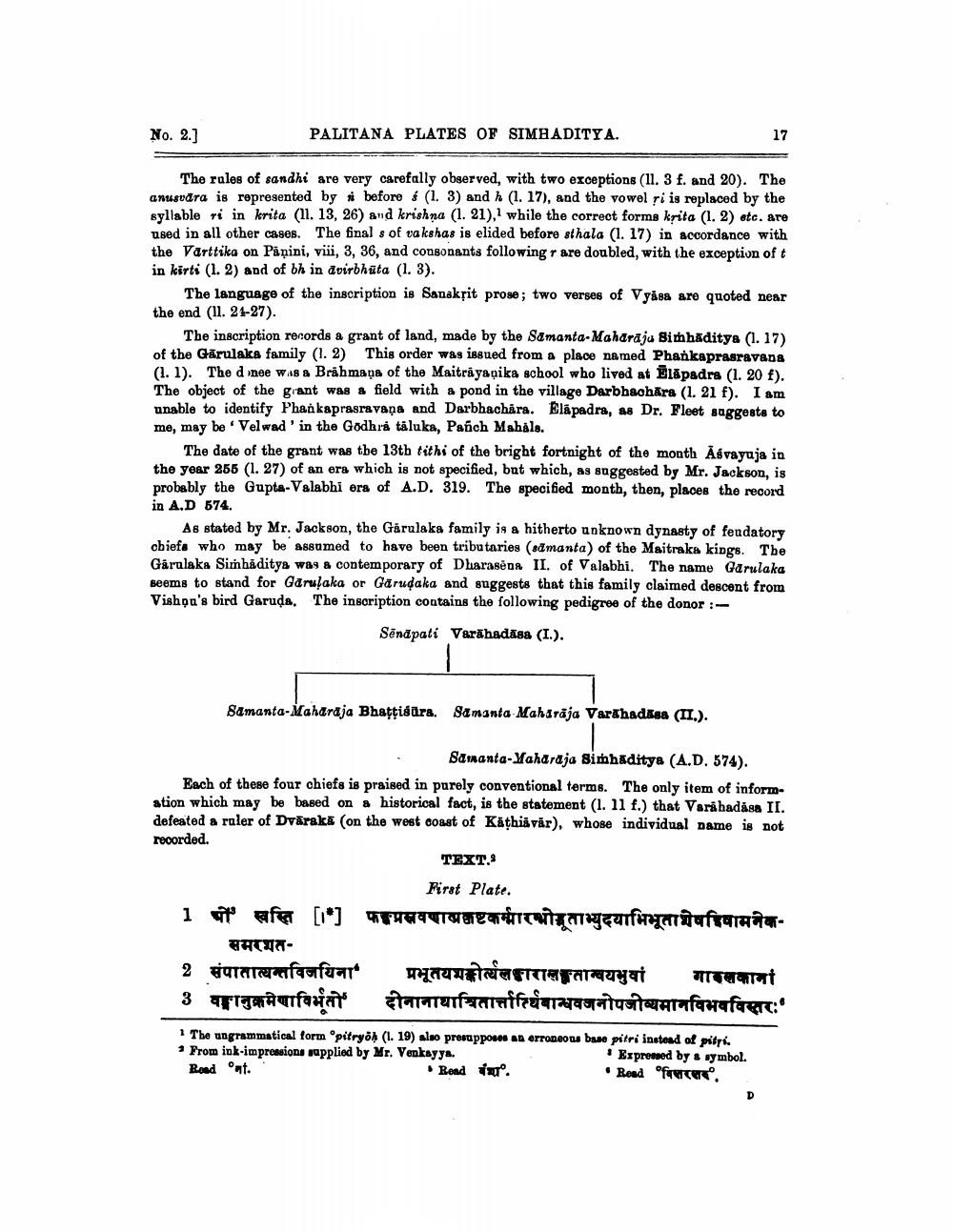________________
No. 2.]
PALITANA PLATES OF SIMHADITYA.
17
The roles of sandhi are very carefally observed, with two exceptions (11. 3 f. and 20). The anusidra is represented by before $ (1. 3) and h (1.17), and the vowel şi is replaced by the syllable ri in krita (11. 13, 26) and krishna (1. 21), while the correct forms krita (1.2) etc. are used in all other cases. The final s of vakshas is elided before sthala (1. 17) in accordance with the Varttika on Pāņini, viii, 3, 36, and consonants following r are doubled, with the exception of t in kirts (1.2) and of bh in dvirbhuta (1. 3).
The language of the inscription is Sanakpit prose; two verses of Vyasa are quoted near the end (1l. 21-27).
The inscription records a grant of land, made by the Samanta-Maharaja Simhaditya (1.17) of the Gārulaka family (1.2) This order was issued from a place named Phankaprasravans (1.1). The d inee was a Brahmaps of the Maitrāyaqika school who lived at Eldpadra (1. 20 f). The object of the giant was a field with a pond in the village Darbhachara (1. 21 f). I am unable to identify Phan kaprasravana and Darbhachära. Eläpadra, as Dr. Fleet suggests to me, may be. Velwad' in the Godhra taluka, Panch Mabals.
The date of the grant was the 13th tithi of the bright fortnight of the month Afvayuja in the year 256 (1. 27) of an era which is not specified, but which, as suggested by Mr. Jackson, is probably the Gupta-Valabhi era of A.D. 319. The specified month, then, places the record in A.D 574.
As stated by Mr. Jackson, the Gårulaka family is a hitherto unknown dynasty of fendatory chiefs who may be assumed to have been tributaries (admanta) of the Maitraka kings. The Gårulaka Simhaditys was & contemporary of Dharasena II. of Valabhi. The name Garulaka seems to stand for Ganulaka or Garudaka and suggests that this family claimed descent from Vishqa's bird Garuda. The inscription contains the following pedigree of the donor :
Sendpati Varāhadāsa (I.).
Samanta Maharaja Bhattisura. Samanta Maharaja Vardhadasa (II.).
Samanta-Yaharaja Simhaditya (A.D. 574). Each of these four chiefs is praised in purely conventional terms. The only item of information which may be based on a historical fact, is the statement (1. 11 f.) that Varahadása II. defeated a ruler of Dvāraka (on the west coast of Käthisvár), whose individual name is not recorded.
TEXT.
H
First Plate.
a tanamageurfotaitaftaraaar
i at fer [*]
HTUA2 संपातात्यन्तविजयिना* 3 बहनुक्रमेणाविर्भतो
प्रभूतयमकोयलसाराम्तहातान्वयभुवां गावसकानां दीनानाथाचितार्तार्थिवान्धवजनोपजीव्यमानविभवविस्तरः
1 The angrammatical form pitryon (1. 19) sloo presupposes an erroneou base pitri instead of pitpi. * Prom ink-impressions rapplied by Mr. Venkayya.
Espressed by a symbol. Rood at.
Read dar
. Read fierce




